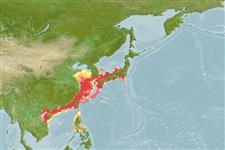Environment: milieu / climate zone / depth range / distribution range
Ekologi
marina; brackvatten bentopelagisk; havsvandrande (Ref. 51243); djupintervall 0 - 120 m (Ref. 43239). Temperate; 38°N - 13°N, 106°E - 141°E
Northwest Pacific: from central Vietnam to South Korea and Japan, Yellow and East China seas.
Length at first maturity / Size / Vikt / Age
Maturity: Lm ?, range 17 - ? cm
Max length : 80.0 cm TL hane/ej könsbestämd; (Ref. 4537); publicerad maxvikt: 243.60 g (Ref. 124479); rapporterad maxålder: 6 år (Ref. 104735)
Taggstrålar i ryggfenan (totalt): 9 - 10; Mjukstrålar i ryggfenan (totalt): 30-35; Taggstrålar i analfenan 2; Mjukstrålar i analfenan: 7 - 9; Ryggkotor: 25 - 26. Body gold when fresh. Soft-rayed portions of dorsal and anal fins mostly covered with scales. Posterior part of pectoral fin not black. Anal soft rays usually 8 (Ref. 41299).
Inhabit coastal waters and estuaries (Ref. 2113). Found in muddy or muddy-sandy bottoms shallower than 120 m depth (Ref. 43239). Feed on crustaceans and fishes.
Life cycle and mating behavior
Könsmognad | Reproduktion | Lek | Ägg | Fecundity | Larver
Masuda, H., K. Amaoka, C. Araga, T. Uyeno and T. Yoshino, 1984. The fishes of the Japanese Archipelago. Vol. 1. Tokai University Press, Tokyo, Japan. 437 p. (text). (Ref. 559)
IUCN Red List Status (Ref. 130435)
Threat to humans
Harmless
Human uses
Fiskeri: kommersiellt viktig; Vattenbruk: kommersiell; Akvarium: Kommersiell
Ytterligare information
MedarbetareBilderStamps, Coins Misc.LjudCiguateraHastighetSimsättGälytaOtolithsHjärnstorlekSyn
Verktyg
Special reports
Download XML
Internet-källor
Estimates based on models
Preferred temperature (Ref.
123201): 20.8 - 24.7, mean 22.8 °C (based on 54 cells).
Phylogenetic diversity index (Ref.
82804): PD
50 = 0.6250 [Uniqueness, from 0.5 = low to 2.0 = high].
Bayesian length-weight: a=0.00891 (0.00582 - 0.01365), b=3.07 (2.95 - 3.19), in cm total length, based on LWR estimates for this species & (Sub)family-body (Ref.
93245).
Trofisk nivå (Ref.
69278): 3.7 ±0.56 se; based on food items.
Generation time: 5.2 ( na - na) years. Estimated as median ln(3)/K based on 2
growth studies.
Resiliens (Ref.
120179): Mellan, lägsta populationsfördubblingstid 1,4-4,4 år (Assuming tm=2-4).
Prior r = 0.30, 95% CL = 0.20 - 0.45, Based on 1 stock assessment.
Fishing Vulnerability (Ref.
59153): Moderate vulnerability (42 of 100).
Climate Vulnerability (Ref.
125649): Very high vulnerability (88 of 100).
Nutrients (Ref.
124155): Calcium = 20.5 [11.6, 37.2] mg/100g; Iron = 0.245 [0.121, 0.428] mg/100g; Protein = 18.9 [17.8, 20.1] %; Omega3 = 0.573 [0.296, 1.059] g/100g; Selenium = 16.5 [8.1, 31.9] μg/100g; VitaminA = 13.9 [4.5, 45.8] μg/100g; Zinc = 0.555 [0.398, 0.808] mg/100g (wet weight); based on
nutrient studies.
